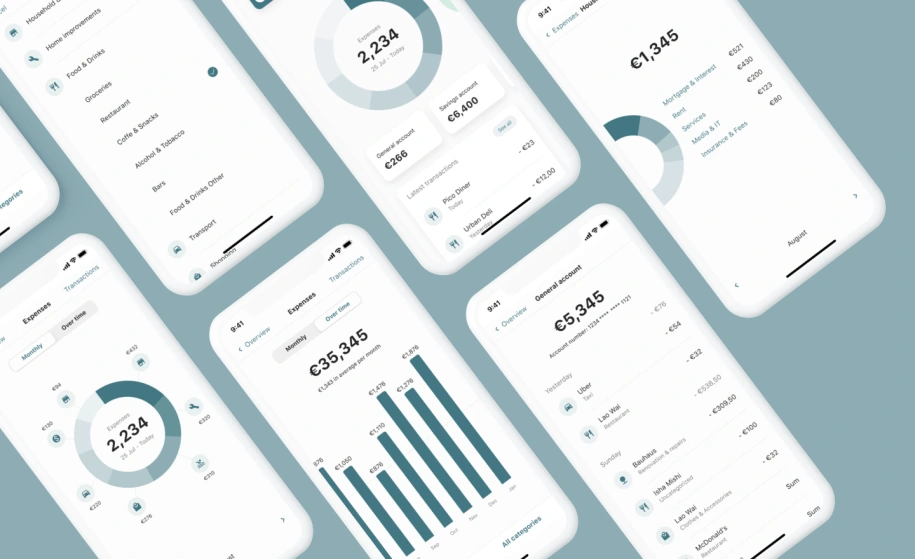What is PFM, and what is it good for?

PFM is a common acronym you’ll find in the world of financial services, and it stands for Personal Finance Management. It usually refers to apps (or software) that help people manage their money. PFM apps can come with a bunch of different features, bringing different benefits for both consumers and businesses.
PFM stands for Personal Finance Management, and refers to apps that help people manage their money.
Many banks offer PFM services for their customers – but any business can provide PFM apps for their customers.
It helps consumers better understand and control their finances.
It can help businesses increase customer engagement and loyalty, and get unique insights.
A PFM app can look like anything. It can provide very simple expense tracking and budgeting features to help people keep tabs on how much they’re spending, and on what.
But it can also have more advanced features, like giving personalised financial coaching based on an automatic analysis of someone’s bank transactions.
Many banks today offer some form of PFM service for their customers as a part of their mobile banking app. But PFM apps can be created by anyone, for anyone. With today’s open banking technology, consumers can share their bank account data with whoever they want.

What does PFM have to offer for consumers?
Anyone looking for a personal finance management service essentially wants the same thing: better understanding and control of their financial lives.
Of course, every individual is unique, and people have different needs, wants and preferences. Hardcore investors might not be looking to get the same from a PFM app as, say, someone who just wants help saving up for a home renovation project.
Naturally, people will get value from different types of features. There is no exact formula for PFM success. But there are two things that can help any product really stand out in this speedy, fully digital, one-click era: convenience and personalisation.
Convenience for better understanding
In the context of PFM, convenience usually translates to automation – the promise of ‘money on autopilot’. A valuable PFM experience removes the need for writing down expenses on a spreadsheet and making calculations. It takes care of the accounting, as transactions happen in real-time.
This helps people immediately understand their financial standing without having to do any mental gymnastics.
Personalisation for better control
Once the accounting is taken care of, the next step is helping people figure out what it all means, and how to achieve their goals. As generic advice often helps no one, a valuable PFM experience needs to provide custom recommendations, based on insights into someone’s specific situation.
Personalised advice based on individual needs is key to helping people take better control of their spending.

What do businesses have to gain by offering PFM?
Just like people, businesses have different needs, goals, and preferred ways of handling their accounting. There are a range of different goals companies might be looking to achieve by giving their customers a great PFM experience.
Increasing engagement and trust
One common goal that PFM could help toward is increasing customer engagement. Especially for banks that offer PFM as part of their banking app, it’s a way to give customers a good reason to keep coming back – simply because it brings them value.
And when businesses can bring real value for their customers – by helping them achieve their goals, giving personalised advice, making them feel taken care of – this can deepen their relationship, also increasing customer loyalty and trust.
Improving results with deeper customer insights
Having unique insights into customers’ finances, habits and preferences can bring with it a host of other business benefits. This is because data-driven insights can help businesses provide a higher level of personalisation to improve their offerings or services.
Those looking to increase revenue or conversion rates, for instance, can use these insights to boost sales by leveraging personalisation. Understanding what a customer likes (and how they like to spend), can help businesses make sure their offers will be relevant, timely, and appreciated.
Personal finance management as a product
At Tink, we've developed a PFM product – Money Manager – that helps businesses quickly create standalone applications or enhance their existing PFM offering. Find out more about it in the product page:
More in Open banking

2025-06-09
11 min read
The case for “Pay by Bank” as a global term
Thomas Gmelch argues that "Pay by Bank" should be adopted as a standard term for open banking-powered account-to-account payments to reduce confusion, build trust, and boost adoption across the industry.
Read more

2025-06-02
3 min read
Tink joins Visa A2A – what it means for Pay by Bank and VRP
Visa A2A brings an enhanced framework to Pay by Bank and variable recurring payments (VRP) in the UK, and Tink is excited to be one of the first members of this new solution.
Read more

2024-11-19
12 min read
From authentication to authorisation: Navigating the changes with eIDAS 2.0
Discover how the eIDAS 2.0 regulation is set to transform digital identity and payment processes across the EU, promising seamless authentication, enhanced security, and a future where forgotten passwords and cumbersome paperwork are a thing of the past.
Read more
Get started with Tink
Contact our team to learn more about what we can help you build – or create an account to get started right away.
